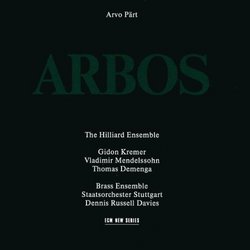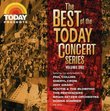| All Artists: Susan Bickley, Arvo Part, Dennis Russell Davies, David James, Hilliard Ensemble, Christopher Bowers-Broadbent, Lynne Dawson, Rogers Covey-Crump Title: Arvo Pärt: Arbos Members Wishing: 2 Total Copies: 0 Label: ECM Records Release Date: 1/25/2000 Genres: Pop, Classical Styles: Vocal Pop, Opera & Classical Vocal, Chamber Music, Forms & Genres, Concertos, Historical Periods, Early Music, Symphonies Number of Discs: 1 SwapaCD Credits: 1 UPCs: 042283195929, 775662689787 |
Search - Susan Bickley, Arvo Part, Dennis Russell Davies :: Arvo Pärt: Arbos
 | Susan Bickley, Arvo Part, Dennis Russell Davies Arvo Pärt: Arbos Genres: Pop, Classical
This CD features some great performances by Pärt specialists of a variety of shorter works. The clamorous Arbos for brass makes a startling opening for those who expect abstracted reverence; the lament, An den Wassern... more » |
Larger Image |
CD DetailsSynopsis
Amazon.com essential recording This CD features some great performances by Pärt specialists of a variety of shorter works. The clamorous Arbos for brass makes a startling opening for those who expect abstracted reverence; the lament, An den Wassern, has a startling ending that builds in intensity and volume only to break off midphrase. The static Pari Intervallo for organ leads into De Profundis, with its sense of slow but unstoppable movement (every note the same length, every measure the same rhythm). Es Sang has an unexpectedly lilting tune for solo alto, punctuated by string exclamations; Summa is a straightforward Pärt-style setting of the Credo. Arbos is repeated (this is oddly satisfying), and the disc closes with a masterpiece, the unbearably sad Stabat Mater for three voices and three strings. --Matthew Westphal Similar CDs
|
CD ReviewsAn icy wind of delicious sadness Bertson B Betterson | Apeville, Florida | 08/16/2004 (5 out of 5 stars) "Arvo Part creates a world where bleakness becomes almost an indulgence, and upon the first hearing of Stabat Mater you'll feel an icy wind of delicious sadness blow over your eager and expectant frown. The solo organ piece Pari Intervallo (which can also be found on the purely organ album Trivium), is a study in restrained and sterile beauty, meaning that the piece (and most of the tintinnabuli pieces) doesn't crash and bellow and forcefully announce its intent, but whispers it in cold hintings. As for myself, I will not hint: buy this album now." An excellent recording of sacred music Steven Guy | Croydon, South Australia | 03/21/2007 (5 out of 5 stars) "This was the first Arvo Pärt recording I ever heard. I think that was around 1993? I heard the Stabat Mater on a long drive from Melbourne to Ballarat, where I was performing in a midday concert of Renaissance and Baroque music as a part of an Arts festival held in that great country city. I was alone in the car, listening to ABC Classic FM, as always, and I heard all of the Statbat Mater. I was captivated by this poignant, sublime and beautiful music. The three soloists, soprano, countertenor and tenor, sing the music with great style and beauty. The melodic lines seem to be weightless and float through each other in a very graceful way. The work is accompanied by a small group of string instruments. I bought the recording when I got back to Melbourne and it has been a favourite of mine ever since. I also bought the Hilliard Ensemble's recording of the Pärt St. John Passion, commonly known as the Passio. Lovers of the music of John Tavener and Henryk Gorecki, who haven't heard any of Pärt's music will be in for a very pleasant surprise." After TABULA RASA, the next stop for fans of Part's "holy mi Christopher Culver | 06/22/2007 (4 out of 5 stars) "This ECM disc is an important document of the work of Estonian composer Arvo Part, containing as it does a number of important early pieces from the composer's "tintinnabuli" phase. If the earlier TABULA RASA on the same label is the traditional entry point into this style, ARBOS is where one should head next. And as with all ECM discs, the performers are Part's hand-picked men, giving a definitive sheen to the recordings.
Those who have heard the TABULA RASA disc are familiar with "Cantus in memoriam Benjamin Britten" for bell and strings. That's a mensuration canon, where various instrumental parts play a descending scale in different speeds, but it is peaceful and contemplative. On this disc "Arbos" for 4 trumpets, 4 trombones, and percussion (1977) takes the same form, but with very different instrumentation, a faster tempo, and louder dynamics it obtains a very different sound. Those who think of Part only as a creator of calm moods will be surprised indeed by this piece which turns the basics of tintinnabuli writing towards a troubled, though fairly static, surface. The Staatsorchester Stuttgart conducted by Dennis Russell Davies gives a confident performance. The other pieces here are performed by the Hilliard Ensemble. "Pari Intervallo" for organ (1976) does with that instrument what "Fur Alina" did with piano, display the sound of tinntinabuli in the simplest possible form. It's notable for being Part's calmest piece for organ; others are somewhat monsters. The title of "An den Wassern zu Babel" for trombone and chamber orchestra (1986) refers to the well-known psalm, but instead of merely setting the text Part communicates the soul of the Israelites' lament though anguished vocalizations. The a capella "Summa" (1986), on the other hand, sets the Nicene Creed without any emotional edge whatsoever, letting the listener soberly listen to its theological truths, a good counter to, say, the Glagolitic Mass of Janacek. "De Profundis" for male chorus, percussion & organ (1980) sets Psalm 130. While the chorus and percussion range everywhere through the seven-minute length of the piece, the organ maintains a slow ostinato much like in "Pari Intervallo". Though Part usually sets Biblical or liturgical texts, "Es sang vor langen Jahren" for counter-tenor or alto with violin & viola (1984) is a setting of a poem by Clemens Brentano talking of a human lover and a nightingale. The music is fairly standard Part, though. Perhaps a little too standard, for I have a hard time enjoying this piece, which doesn't do much to stand out. "Stabat Mater" (1987) is at 25 minutes the longest piece on the disc, and one of Part's greatest achievements. A setting of the well-known hymn, it consists of alternating sections focusing either on chorus or the violin, here performed by the great Gidon Kremer. The text telling of the Theotokos sorrowfully gazing at Christ on the Cross is, as one can expect, set solemnly indeed, but surprising are the joyful dance-like cadences led by the violin that break in. While most of the music here is mainstream tintinnabuli, "An den Wassern zu Babel" (1976) is unusual, coming after Part's creative silence but not squaring with his new style. It displays the composer's interest in medieval music, and is closer to his Symphony No. 3 of several years previously than to "Fur Alina" written the same year and the tintinnabuli pieces that have followed. One regrets that ECM places "Arbos" here twice--the label is infamous for rarely putting together enough material to nicely fill a disc. That and the presence of the frankly dull "Es sang for langen Jahren" causes me to subtract a star. Nonetheless, those who have heard TABULA RASA and want to head deeper into Part's singular soundworld are highly encouraged to check out this disc which, as a fellow reviewer noted, is strangely neglected." |

 Track Listings (8) - Disc #1
Track Listings (8) - Disc #1![John Anderson - Greatest Hits [BNA]](https://nationalbookswap.com/cd//m/30/1530/241530.jpg)


